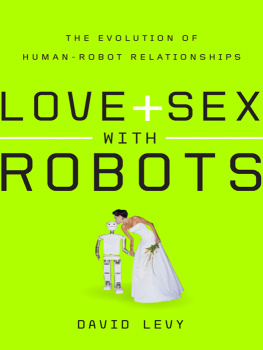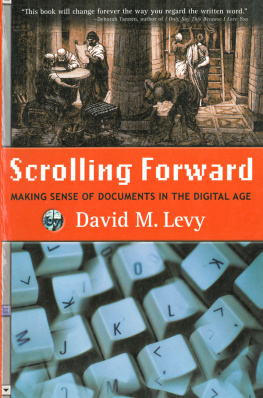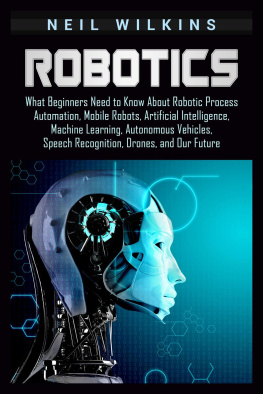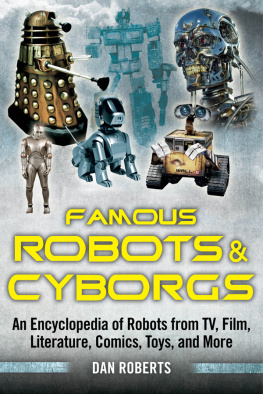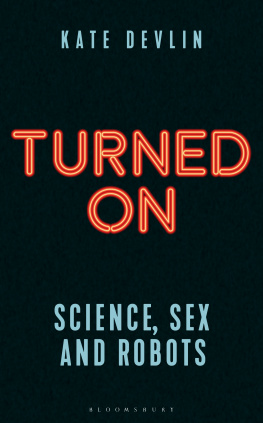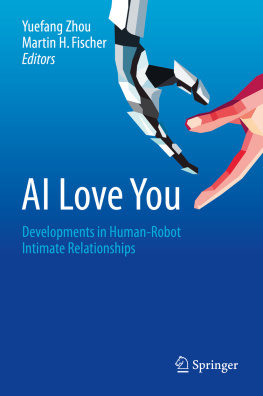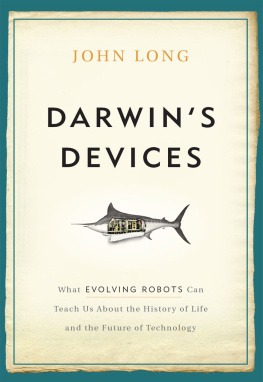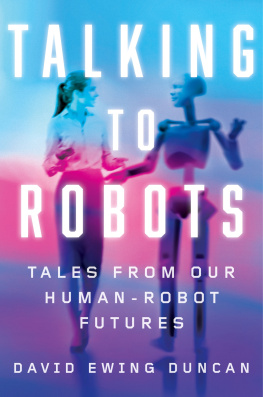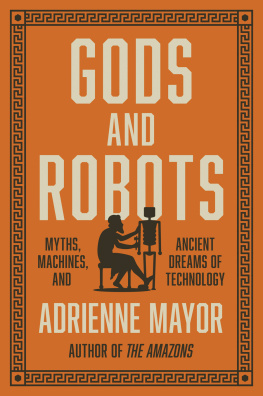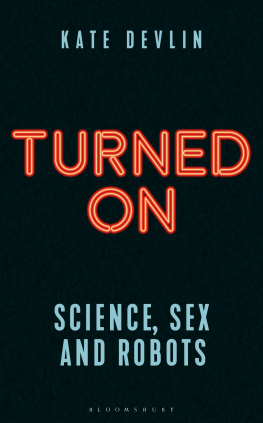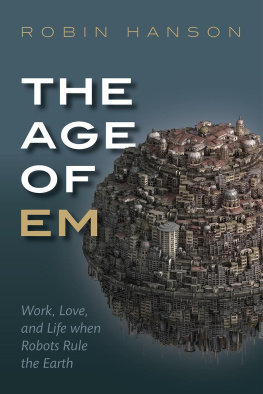To Anthony, an MIT student who tried having girlfriends but found that he preferred relationships with computers. And to all the other Anthonys past, present, and future, of both sexes.
According to the United Nations Economic Commission for Europes World Robotics Survey, in 2002 the number of domestic and service robots more than tripled, nearly outstripping their industrial counterparts. By the end of 2003, there were more than 600,000 robot vacuum cleaners and lawn mowers, a figure predicted to rise to more than 4 million by the end of next year. Japanese industrial firms are racing to build humanoid robots to act as domestic helpers for the elderly, and South Korea has set a goal that 100 percent of households should have domestic robots by 2020. Probably the area of robotics that is likely to prove most controversial is the development of robotic sex toys, says Dr. Christensen. People are going to be having sex with robots in the next five years, he says. Initially these robots will be pretty basic, but that is unlikely to put people off, he says. People are willing to have sex with inflatable dolls, so initially anything that moves will be an improvement.
The Economist, June 8, 2006, quoting Henrik Christensen, chairman of the European Robotics Network at the Swedish Royal Institute of Technology in Stockholm
Recent research shows that people perceive and treat robots not just as machines, but also as their companions or artificial partners.
Alexander Libin and Elena Libin, 2004
At the dawn of the twenty-first century, mankind is experiencing an era of phenomenal scientific and technological achievement. Whole disciplines of science that were unheard of even a few decades ago are now making possible amazing feats in areas such as cell-phone technology, computer technology, space research, and medicine. Furthermore, our scientific knowledge is growing at a rate that is itself increasing. The more we know about a science, the more quickly we may use our knowledge to discover even more within that science. This has been very much the case in the field of computing, a science that (like me) was in its infancy in the early 1950s. In those days each of the few computers that had been built would fill a room and cost a fortune. And although articles about computers appeared from time to time in the popular press, few people had any idea what these newfangled machines could be used for. When, in 1943, an American company called International Business Machines first considered the possibility of manufacturing computers on a commercial basis, the companys founder and president, Thomas J. Watson, pessimistically predicted, I think there is a world market for maybe five computers. How wrong he was! Instead of the computers being something of a commercial white elephant, it became the product for which IBM is best known. And by 1981 the computer had become so ubiquitous in industry, in the office, and in academic life that IBM launched a whole new product category called the personal computer, the PC, a computer that was not only more powerful than the multimillion-dollar machines of twenty years earlier but was also affordable for many families and individuals.
Commensurately with this dramatic growth in the popularity of the computer as a tool for all to use, computer science became a subject that was increasingly studied at universities and research institutes. And within computer science there came an even newer discipline, called artificial intelligence, Programs that carry on conversations or translate from one language into another are encompassed within the AI discipline of natural language processing. And among the other disciplines within AI there is robotics.
The word robot was suggested by Josef Capek in discussion with his more famous brother, the Czechoslovak writer Karel Capek. It is derived from the Czech robota (forced labor) and was first revealed in the West when Karel used it in the title of his play Rossums Universal Robots ( R.U.R. ), an immediate hit when it was first shown on Broadway. The literal meaning of robot is worker. The robots in C? apeks play were creature machines, resembling humans in appearance, designed and built to serve as workers for their human masters.
Although the word robot was new in the early 1920s, the idea of an artificial form of life was by no means a new one in Capeks day. Inventors and engineers had for millennia devised automata that simulated some of the functions of living creatures. One of the earliest to do so was Heron constructed some water-powered mechanical birds, entire flocks of them, that even emitted realistic chirping sounds created by a water-driven device.
The publics fascination for automata reached its first peak in France in the eighteenth century. One example of this genre was a menacing mechanical owl set amid a group of smaller birds, designed in 1644 by the French engineer Isaac de Caus. The smaller birds would flutter their wings and chirp while the owl slowly moved on a pivot to face them. As the owls face turned toward the smaller birds, appearing to threaten them, they became still and stopped their chirping. When the owls face then turned away from the group, the smaller birds came alive again. The whole mechanism was driven by a water wheel that controlled the actions of each bird by means of a metal cylinder, the surface of which was embedded with pins, just like a music box. As the cylinder turned via the force of the water, the pins on the cylinder would engage with a music boxlike mechanism so that each pin created its own effect or movement in one of the birds.
Following de Causs example, at least two other French automaton inventors also used birds as the embodiments for some of their mechanical marvels. In 1733 an inventor named Maillard designed a mechanical swan that would paddle through the water while its head moved slowly from side to side. Maillards idea was as simple as it was clever: a paddle wheel, similar to those found in the Mississippi River steamboats, propelled the swan forward while simultaneously connecting, via a system of gears, with the swans head; as the paddle wheel rotated, it thus served a dual purpose, creating the forward motion of the swans body and the simultaneous side-to-side motion of its head. An even more advanced idea, and a more entertaining example of this genre, was a mechanical defecating duck, the creation of Jacques Vaucanson. The duck could bend its neck, move its wings and its feet, and it could eat. It would stretch out its neck to peck at corn offered by a human hand, then swallow, digest, and finally excrete it, the corn having been turned into excrement by a chemical process, according to Vaucanson. In fact the digestion and excretion processes were parts of a hoax. The corn, once eaten, was held in a receptacle at the lower end of the ducks throat, while the ducks excrement was not genuine duck droppings but some other material that had been inserted in the ducks rear end prior to the demonstration.
That Vaucansons duck did not actually digest its food and defecate in no way diminishes its contribution as a precursor to humanlike robotics. One of the principal achievements of Vaucanson and his peers was the stimulation of widespread interest in the mechanical aspects of what is now known as artificial life. That era saw the creation of automata that could not only eat but also breathe; automata with soft skin, flexible lips, and delicately moving jointed fingers.
While Vaucanson and his peers managed the simulation of physiological and other natural bodily processes, there were other inventors who focused on simulating the processes of thought. One of the best known of these peers was, like Vaucanson, also famous for a machine that turned out to be a hoax. In the closing years of the eighteenth century, Baron Wolfgang von Kempelen, a scientific adviser to the royal court of Vienna, designed a chess-playing automaton in the guise of a Turk seated on a wooden box. Despite Kempelens assurances to the contrary, and his magician-like demonstrations to convince his audiences that the wooden box contained nothing untoward, there was in fact a (small) strong human player secreted in the box, a player who vanquished all chess enthusiasts who tried their luck against the Turk.

